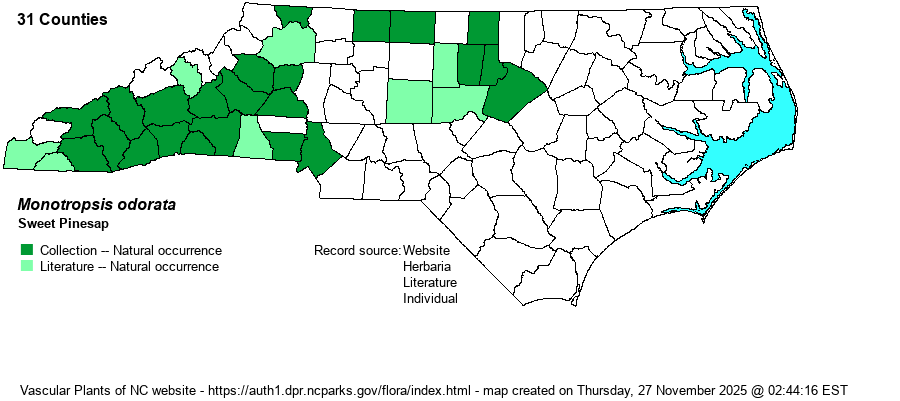| Section 6 » Order Ericales » Family Ericaceae |
Show/Hide Synonym
| taxonName | relationship | relatedTaxonName | relatedTaxonRefText | relComments |
|---|
|
|
|
|
|
|
| Monotropsis odorata | < | Monotropsis odorata | Gleason and Cronquist (1991) | | | Monotropsis odorata | < | Monotropsis odorata | Fernald (1950) | | | Monotropsis odorata | < | Monotropsis odorata | Flora of North America (1993b, 1997, 2000, 2002a, 2002b, 2003a, 2004b, 2005, 2006a, 2006b, 2006c, 2007a, 2009, 2010) | | | Monotropsis odorata | < | Monotropsis odorata | Gleason (1952) | | | Monotropsis odorata | < | Monotropsis odorata | | | | Monotropsis odorata | < | Monotropsis odorata | | | | Monotropsis odorata | < | Monotropsis odorata | Wofford (1989) | | | Monotropsis odorata | < | Monotropsis odorata | Flora of West Virginia | | | Monotropsis odorata | < | Monotropsis odorata | Stevens et al. in Kubitzki (2004). | | | Monotropsis odorata | > | Monotropsis odorata var. odorata | Radford, Ahles, and Bell (1968) | | | Monotropsis odorata | > | Monotropsis odorata var. lehmaniae | Radford, Ahles, and Bell (1968) | | | Monotropsis odorata | > | Monotropsis odorata | Small (1933, 1938) | | | Monotropsis odorata | > | Monotropsis lehmaniae | Small (1933, 1938) | | | Monotropsis odorata | = | Schweinitzia odorata 1818 | | | | Source: Weakley's Flora |
|
| Author | Schweinitz ex Elliott | |
| Distribution | Essentially throughout the Mountains and foothills of the western Piedmont. Widely scattered over nearly the rest of the Piedmont, but seemingly absent in the southeastern Piedmont and in the far northeastern Piedmont. Likely scarce in the higher elevations of the northern Mountains.
This has a fairly restricted range, as the G3 Global Rank would suggest. It is centered on the southern Appalachians, ranging north to MD and WV and south to north-central GA and central AL. It is absent in the Atlantic Coastal Plain.
| |
| Abundance | Uncommon and easily overlooked, at lower elevations of the Mountains and western Piedmont. Rare to absent in the higher elevations, however. Farther eastward, generally rare east to the Triangle region (Orange, Durham, and Wake counties). Not known from the Coastal Plain. This is a Significantly Rare species. | |
| Habitat | This species grows on strongly acidic soils of bluffs or slopes, typically near tall ericads such as Mountain Laurel (Kalmia latifolia) or Rosebay Rhododendron (Rhododendron maximum). The forested canopy can be pines or hardwoods. |
| Phenology | The species most often blooms in late winter or early spring, often before hardwood leaves appear -- February to April; however, it may bloom in the fall, such as from September to November. It typically fruits about two months after flowering. | |
| Identification | As with its cousins in the genera Monotropa and Hypopitys, it is also saprophytic and lacks chlorophyll. However, this species is much shorter than them, with relatively larger flowers. The entire plant is often just 1.5-4 inches tall; plants emerging in late winter tend to be yellowish or tawny in color, with several drooping purplish flowers; the leaves are closely appressed to the stem, such that the entire plant is a tiny "seahorse" shape. Plants that emerge in fall are somewhat lavender in color, but still have purplish flowers. This tiny species is often covered by fallen leaves and can thus be hard to spot, but it has a distinctive fragrance that some people (but certainly not all) can detect just by their noses! Thankfully, as with the other saprophytic species named above, it almost always grows in very tight clusters of plants, often 5-25 plants growing in just a few square-inches. Finding the species, without locating a known colony, is a thrilling experience. However, oftentimes, the population you find will be one in fruit, being rather blackened and with the capsule erect, rather than drooping. | |
| Taxonomic Comments | None as a species, but RAB (1968) and perhaps other references named varieties for the plants blooming in late winter (var. odorata) as opposed to those blooming in the fall (var. lehmaniae). Weakley (2018) does not consider varieties to be warranted.
| |
| Other Common Name(s) | Pygmy-pipes, Appalachian Pygmy-pipes | |
| State Rank | S3 | |
| Global Rank | G3 | |
| State Status | SR-O | |
| US Status | | |
| USACE-agcp | | |
| USACE-emp | | |

